Is Plant Based Meat Better for Humans and the Environment?
Last Updated: May 9th, 2021
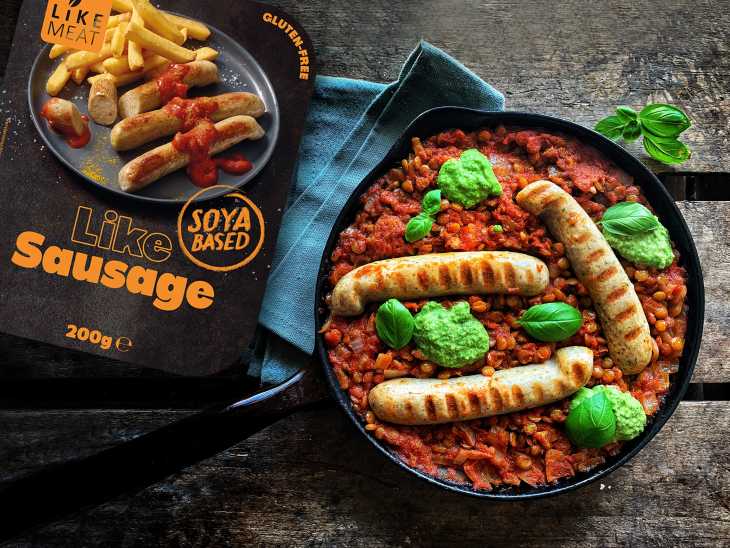
Did you know that we consume around 350 million tons of meat each year on a global scale? That number shows no signs of decreasing anytime soon. Even though meat certainly can satisfy our taste buds, meat production has only intensified the pressure on Earth’s natural ecosystems.
However, there might be a new solution on the horizon. It’s none other than plant-based meat, which is a relatively new creation that could change the meat industry as we know it.
But what exactly is it? In short, this type of meat is entirely plant material, but made with the same texture, taste, and appearance as any real meat you would eat.
Though it might seem like a completely new concept to you, these plant-based meats might have already been in your supermarket aisles without you ever having realized it. Do the brands Quorn, Beyond Meat, and Impossible Foods ring a bell? Those are only a few of the growing options that you could potentially add to your next meal.
No matter how innovative plant-based meat might seem, it’s natural to have some doubts. Could plant based meat ever truly imitate the real thing? And what about it makes it so healthy? Could you possibly even consider going vegan?
Without further ado, let’s determine whether plant-based meat is truly better or not for you and for the environment in this growing industry.
1. What Exactly Is Plant Based Meat?
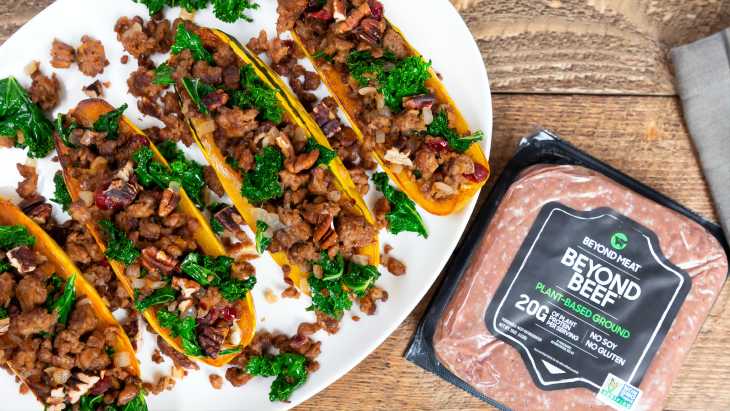
By now, you know that plant-based meat is just plant material made to look, feel, and taste like the real thing you’d buy from the butchers.
Because of how fast the popularity of this meat is rising, you might just be able to find it right in the freezer aisle of your grocery store. These days, you could possibly even obtain a fresh cold cut from your deli section.
But what exactly would you find? There’s as big of a variety in plant-based meats as there are in real meats. You can find sausages, burger patties, nuggets, ground meat, fish, and even shrimp to name a few.
When it comes to types, plant-based meat falls into two categories: whole muscle meat and restructured meat. The former is manufactured to mimic whole steaks, chicken breasts, and any animal muscle while the latter resembles meat products like meatballs, nuggets, and ground beef.
Often, the most common ingredients of these plant-based meats involve vegetable protein extract, coconut oil, beans, soy, beet juice extract, rice, spices, and vital wheat gluten or seitan.
As you can see, all these ingredients are vegan. Who knew that you could potentially be vegan and enjoy meat as well? If you’re considering adopting this diet plan, then read on to learn more about why goin vegan could be wonderful for you.
2. Why Go Vegan?

When you go vegan, that means you won’t eat any foods that come from animals. Not only will the animals benefit from this wise decision, but you’ll also experience plenty of health benefits. In particular, there’s a lot to be gained from going with a meat substitute such as vegan meat.
You’ll suddenly be opened up to a ton of healthy options that you might have neglected before, like whole grains, vegetables, fruits, nuts, and seeds. That means your intake will be stacked with necessary fibers, vitamins, and minerals that your body needs to function at its prime. Additionally, you’ll be lowering the amount of bad stuff that you take in from an overconsumption of red meat products.
Research has shown that vegan diets reduced high blood pressure and cholesterol, which in turn significantly boosts your cardiovascular and heart health. On top of that, vegan meat helps lower your risk of cancer, type 2 diabetes, and strokes.
This allows you to get your creative juices flowing when it comes to your cooking and meal plans. The beauty of vegan meat is that it allows you to enjoy the same great taste of meat but in a much healthier way.
However, there’s plenty of goodness that going vegan can bring beyond taste and nutrition alone. By now, you might have already guessed that real meat has a huge environmental impact. It takes 75 times more energy alone to produce meat than corn. Not only is the energy requirement large, but the amount of land needed to feed livestock animals as well. With so many resources dedicated to meat production, there’s no doubt that the Earth’s ecosystem suffers.
In choosing to go vegan, you’re doing your part to reduce greenhouse gas emissions and help with water conservation. As a whole, global warming slows just a little more thanks to your actions.
Another huge motivation for many to go vegan is to protect the animals. In the meat industry, it’s all too common for animals to be exploited and bred just for the purpose of being funneled into the slaughterhouse. Additionally, animal cruelty is just as frequent. Going vegan helps bring about better welfare for the animals so that they can enjoy better livelihoods.
Overall, vegan plant-based meat is a hugely sustainable source of food that benefits not only you, but the animals and environment around you.
3. The Nutritional Breakdown
Not yet totally convinced that plant-based meat is healthier than actual meat products? The proof is in the pudding with the numbers alone. Take a look at this nutritional breakdown between the vegan and real options of beef and chicken to get a good sense of just how much healthier vegan meat is.
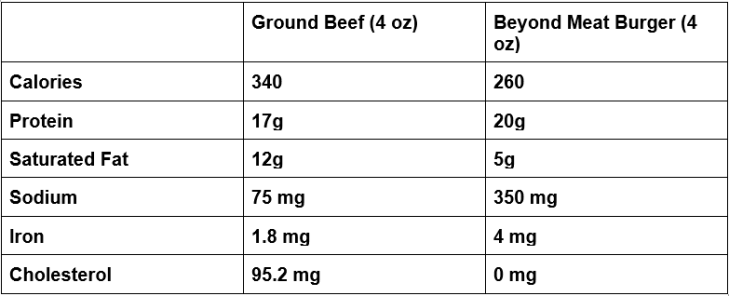
Source: FoodData Central; Beyond Meat
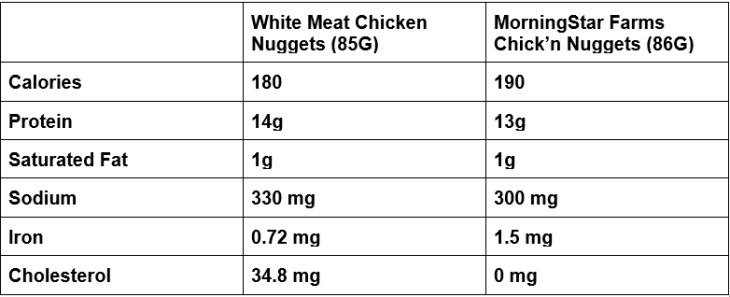
Source: FoodData Central; Kellogg
4. How to Get Started With a Simple Vegetarian Meal Plan?
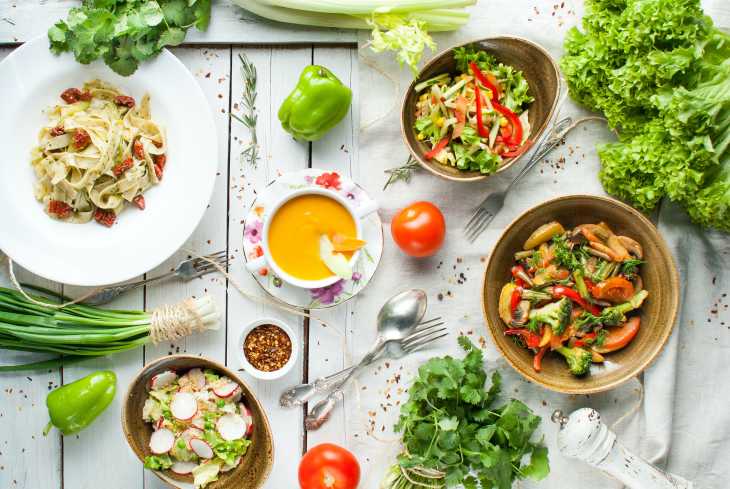
If you’re not ready to fully go vegan just yet, a great step in the right direction is to go vegetarian. Confused on the difference? A vegan diet specifically excludes all meat and animal products while a vegetarian diet only excludes meat, poultry, fish, and seafood.
Once you’ve chosen this new lifestyle, you might anticipate a whole big challenge before you. However, by following our simple vegetarian meal plan, you’ll find that the process is so much easier, tastier, and healthier than you’d expect.
All it takes is a little forethought and planning before you start the eating part. As long as you follow some simple steps, you’ll quickly discover the benefits of a meat-free lifestyle that adopting a vegetarian meal plan can bring.
Let’s start off with the list of recommended foods to eat. You already know that meat is off limits, but what’s on the table instead? Have a look:
Plenty of vegetables
Eat fruits for desserts
A handful of seeds
Eggs or fish
Have a protein source such as vegan meat, beans, tofu, seitan, or other meat substitutes
Include whole grains for breakfast such as rice, oats, and quinoa
Get in your beans and legumes (including soy) in
Nuts such as almonds, cashews, pecans, and walnuts
Any foods that contain little to no additional sugars, processed ingredients, or unhealthy fats
In knowing the best food options for your vegetarian diet, it can seem even harder to sit down and actually plan out your exact meal combinations. However, there are tons of meal plans out there that can do the grunt work for you and spur your creativity. To get your juices flowing, we’ve prepared a sample vegetarian meal plan for you that has all three meals of the day thought out for an entire week.
Monday
Breakfast: Oatmeal made with coconut milk and topped with berries, shredded coconut, and assorted nuts
Lunch: Veggie wrap
Dinner: Whole-wheat pasta with roasted tomatoes and basil
Tuesday
Breakfast: Overnight baked eggs bruschetta
Lunch: Rice and white bean soup
Dinner: Grilled veggie pizza
Wednesday
Breakfast: Shakshuka
Lunch: Roasted sweet potato salad with vinaigrette
Dinner: Enchiladas
Thursday
Breakfast: Protein parfait
Lunch: Mediterranean bulgur bowl
Dinner: Lentil tacos
Friday
Breakfast: German apple pancake
Lunch: Roasted sweet potato and chickpea pitas
Dinner: Pepper ricotta primavera
Saturday
Breakfast: Oatmeal waffles topped with fruits
Lunch: Mozzarella mushrooms with garlic toast
Dinner: Vegetarian Pad Thai
Sunday
Breakfast: Portobello mushrooms Florentine
Lunch: Quinoa-stuffed squash boats
Dinner: Black bean tortilla pie
5. Conclusion
See, that wasn’t so bad, was it? Contrary to the popular stereotype that going vegan or vegetarian involves giving up good tasting food, you’re actually gaining far more in terms of taste, health, and overall goodness.
No matter how wonderful you thought real meat might have tasted, vegan meat can provide you with the same experience and more. In looking ahead, plant-based foods are only gaining popularity and have the potential to completely transform the foodscape as we know it. As climate change becomes an increasing problem, these meat substitutes might just be the future everyone has to inevitably pay attention to. In transitioning to veganism or vegetarianism now, you’re putting your best foot forward for your own palette and the planet.
